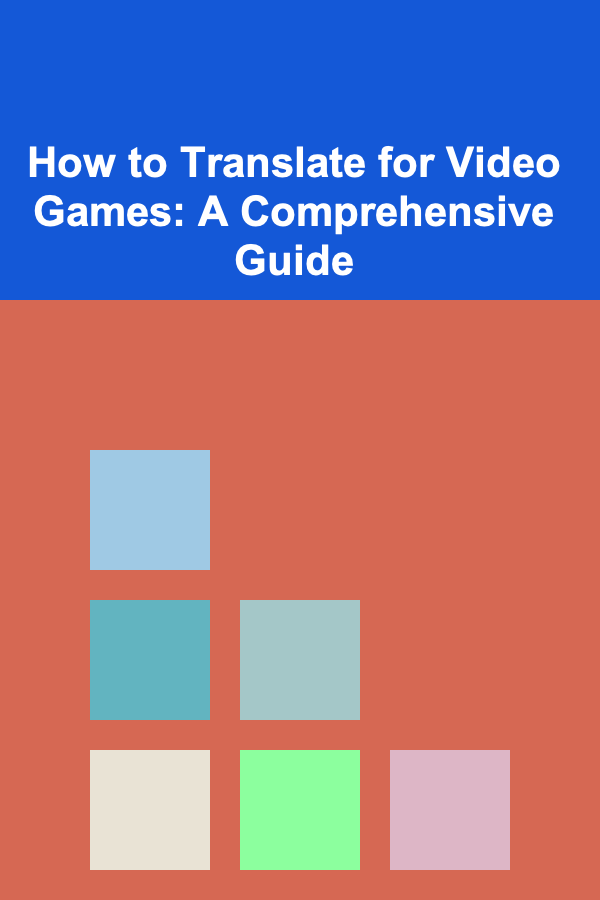
How to Translate for Video Games: A Comprehensive Guide
ebook include PDF & Audio bundle (Micro Guide)
$12.99$5.99
Limited Time Offer! Order within the next:

Video game translation is an intricate and evolving field. Unlike other types of translation, video game localization goes beyond just converting text from one language to another. It involves adapting the game's narrative, dialogue, cultural references, and technical elements to meet the expectations of players in different regions. This is a critical process because it ensures that players from various parts of the world can enjoy the game in a way that feels natural and culturally appropriate.
In this comprehensive guide, we will explore the ins and outs of video game translation, from understanding the key aspects of localization to best practices and challenges involved. Whether you're a budding translator looking to break into the industry or an experienced linguist seeking to refine your skills, this guide will provide you with the knowledge and tools needed to succeed in this exciting and dynamic field.
The Basics of Video Game Translation
Before diving deep into the specifics of video game translation, it's essential to understand the scope of the task. Video game translation involves the conversion of text, dialogue, and other written content in a video game from the source language into the target language. However, video game translation does not merely involve text conversion---it requires a deep understanding of cultural nuances, technical constraints, and the context of the game.
The Role of Localization
Localization (often abbreviated as "l10n") is the broader process that video game translation falls under. Localization ensures that a game is adapted to meet the linguistic, cultural, and social expectations of players in a different market. While translation deals strictly with language, localization encompasses the broader process, which may include:
- Cultural adaptation: Adjusting content so that it resonates with players from different regions.
- Graphics and design modification: Adapting graphics, symbols, and even the user interface (UI) to fit local preferences.
- Audio localization: This includes voice acting or audio cues being adapted or re-recorded in the target language.
- Legal and regulatory compliance: Ensuring that the game meets the specific legal standards of the target country (such as censorship or age-rating regulations).
Localization is an important process because it aims to preserve the integrity of the game while ensuring that the game is as accessible, enjoyable, and relevant to players in other regions as possible.
Key Aspects of Video Game Translation
- Text Translation: The most basic element of video game translation is converting written content such as dialogues, quest text, item descriptions, menus, and tutorials into the target language. The challenge here is maintaining accuracy while ensuring that the text is engaging, idiomatic, and appropriate for the game's tone and style.
- Cultural Sensitivity: One of the main challenges in game translation is ensuring that cultural references and jokes make sense in the target language. Video games often contain culturally specific humor, idioms, slang, or historical references that may not be directly translatable. Translators must adapt these references so that they resonate with the local audience, without losing the meaning or humor intended.
- Voiceover Translation: Many video games feature voice acting in addition to written text. Voiceover translation requires not only linguistic proficiency but also an understanding of character tone, emotions, and timing. Translators working on voiceover scripts need to consider lip sync, voice pitch, and how dialogue will sound when performed in a different language.
- Interface and Menu Translation: Translating user interfaces, menus, and HUD elements (heads-up display) is another critical aspect. These elements need to be translated in a way that fits within the space constraints of the original design, which can be particularly challenging when the target language takes up more space than the source language.
- Technical Constraints: Game translation is often subject to technical constraints, such as character limits for text fields, screen sizes, and formatting issues. For example, a character name or a title might fit perfectly in English but may be too long in another language. Translators need to be mindful of these issues and work closely with game developers and designers to ensure that text fits and displays correctly in the game.
- Terminology and Consistency: Video games often introduce specific terminology, such as unique names for characters, places, items, and concepts. Keeping this terminology consistent across all localized versions of the game is crucial for maintaining continuity. Terminology databases, glossaries, and style guides are essential tools for translators to ensure accuracy and consistency.
- Player Experience: Above all, game translation is about creating an immersive and enjoyable experience for the player. The goal is to make the player forget they are reading a translation and feel as though they are playing an original version of the game in their native language. To achieve this, the translator must strike a balance between faithfulness to the original content and making the game engaging for the target audience.
The Process of Translating a Video Game
Translating a video game is not a one-step process. It is a multi-phase procedure that involves collaboration between translators, developers, designers, and other stakeholders. Below is an outline of the typical steps involved in video game translation.
1. Pre-Translation Preparation
The first step in the process is understanding the game and its context. Translators need to familiarize themselves with the game's story, gameplay mechanics, and overall tone. In some cases, a detailed style guide will be provided, including instructions on how the dialogue should be translated, preferred terminology, and tone considerations.
Additionally, translators may be given access to a glossary of terms, a list of in-game characters, and a breakdown of the game world. This preparation phase helps ensure that translators are aligned with the developer's vision for the game.
2. Translation
Once the preparatory work is completed, the actual translation begins. Translators work through the game's scripts, which can involve hundreds of thousands of words depending on the game's complexity. During this phase, it's important to translate not just the words, but the meaning behind them. This requires creativity and flexibility, especially when dealing with idioms, jokes, and cultural references.
During translation, it's essential to keep track of consistency in terminology. Many translators use Translation Memory (TM) tools, which store previously translated phrases and words for future reference. This ensures that the same terms are used consistently throughout the game and reduces the risk of errors.
3. Quality Assurance and Testing
After translation, the next step is quality assurance (QA) testing. This phase ensures that the translated text fits correctly within the game and that there are no typos, errors, or formatting issues. QA testers also check for cultural or linguistic inaccuracies. For example, they may identify areas where the translation doesn't make sense or where the cultural adaptation falls flat.
In addition, voiceovers may be tested during this phase to ensure that the new recordings align with the lip-syncing and emotions of the original characters. Any discrepancies are addressed during the QA phase.
4. In-Game Testing
In-game testing involves checking the game itself to ensure that everything functions as intended after the translation. This includes ensuring that the translated text is properly displayed on screens, menus, and in dialogues. It also involves checking that all elements of the user interface are clear and easy to navigate for players in the target language.
Testers also look for bugs or glitches that may arise due to the translation, such as text overflowing from a box or elements not aligning properly with the game's visuals.
5. Post-Translation Review
Once the game has gone through QA and testing, there may be a final review phase. This is where the translators, along with the developers and other stakeholders, review the final product to ensure everything is in place and that the translation is accurate and culturally appropriate.
The review phase also includes ensuring that the tone, narrative voice, and atmosphere are consistent across the entire game. It is essential that the translated game feels like a seamless, immersive experience for players, with no awkward or jarring moments.
Tools and Technologies in Video Game Translation
In the world of video game translation, various tools and technologies can aid translators in their work. Here are some of the most commonly used tools in the industry:
1. Translation Memory (TM) Tools
Translation Memory tools like SDL Trados Studio or MemoQ allow translators to store previously translated phrases and reuse them in future translations. This helps maintain consistency across the game and speeds up the translation process.
2. Localization Management Platforms
Platforms like Crowdin or Smartling allow developers and translators to manage localization projects collaboratively. These platforms enable the efficient tracking of translation progress, review cycles, and integration into the game's development pipeline.
3. Glossaries and Style Guides
Glossaries and style guides are essential for maintaining consistency in terminology and tone. These documents ensure that all translators working on a project use the same language and style, making the final product coherent and unified.
4. In-Context Tools
In-context tools, such as those used in Crowdin or Lokalise, allow translators to see how the text will appear within the game, providing context for their translations. This is especially important for UI text, where screen space is limited.
5. Voiceover Recording Tools
For games with voice acting, specialized software is used to record, edit, and synchronize voiceover lines. Programs like Pro Tools and Audacity are commonly used by audio engineers to record and edit dialogue in the target language.
Challenges in Video Game Translation
Translating video games is not without its challenges. Some of the most common difficulties include:
- Cultural Sensitivity: Adapting content to suit different cultural norms is one of the most challenging aspects of video game translation. Certain jokes, symbols, or references may not be appropriate or may not make sense in the target culture, requiring adjustments or replacements.
- Space Limitations: In many cases, the target language may take up more or less space than the original text. This can be a problem for UI text, where limited space means that the translation needs to fit within the allotted area without compromising the meaning.
- Voiceover Synchronization: Matching translated dialogue to pre-recorded animation or lip-syncing can be challenging. Sometimes the length of the translated dialogue may not align with the original, requiring adjustments to the script or re-recording of voice lines.
- Technical Limitations: Video games often have strict technical requirements for text rendering. This includes issues like character encoding, font compatibility, and displaying non-latin characters.
Conclusion
Translating video games is an exciting yet complex task that requires more than just linguistic knowledge. A successful video game translator must understand the nuances of culture, be able to work with technical constraints, and ensure that the player experience remains intact in the localized version. By balancing accuracy, creativity, and cultural adaptation, translators play a pivotal role in bringing video games to global audiences and helping them experience the magic of gaming in their own language.
In the fast-growing and competitive gaming industry, video game translation is an indispensable part of ensuring that games are enjoyed by players worldwide. With the right tools, strategies, and expertise, translators can help bridge the gap between different cultures and make video games more inclusive and accessible to all.
Reading More From Our Other Websites
- [Personal Care Tips 101] How to Incorporate Hair Serum into Your Nighttime Hair Care Routine
- [Screen Printing Tip 101] Eco-Friendly Screen Printing: Sustainable Practices for Fabric Designers
- [Personal Financial Planning 101] How to Transform Your Financial Future by Applying Key Lessons from Personal Finance Books and Creating a Personalized Action Plan
- [Paragliding Tip 101] Common Pitfalls and How to Avoid Them When Applying for Your Paragliding License
- [Home Party Planning 101] How to Make Healthy Party Snacks for Kids: Fun and Nutritious Ideas for Little Guests
- [Organization Tip 101] How to Create a Guest Checklist for Easy Hosting
- [Home Cleaning 101] How to Create a House Cleaning Checklist for a Spotless Home
- [Home Security 101] How to Train Your Family on Home Security and Safety Procedures
- [Personal Financial Planning 101] How to Choose the Right Investment Accounts for Your Goals
- [Home Budget Decorating 101] How to Use Rugs to Transform Your Space on a Budget

Affordable Home Gym Setup Ideas: Get Fit Without Breaking the Bank
Read More
How to Create a Family Water Fight for Summer Fun
Read More
How to Create a Realistic Budget and Stick to It
Read More
How to Promote Healthy Sibling Bonds
Read More
How to Conserve Water for Wildlife Habitats
Read More
10 Tips for Skiing in Deep Powder
Read MoreOther Products

Affordable Home Gym Setup Ideas: Get Fit Without Breaking the Bank
Read More
How to Create a Family Water Fight for Summer Fun
Read More
How to Create a Realistic Budget and Stick to It
Read More
How to Promote Healthy Sibling Bonds
Read More
How to Conserve Water for Wildlife Habitats
Read More